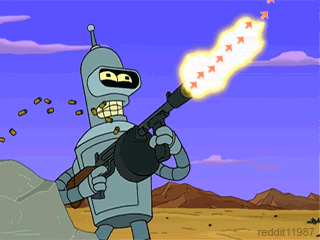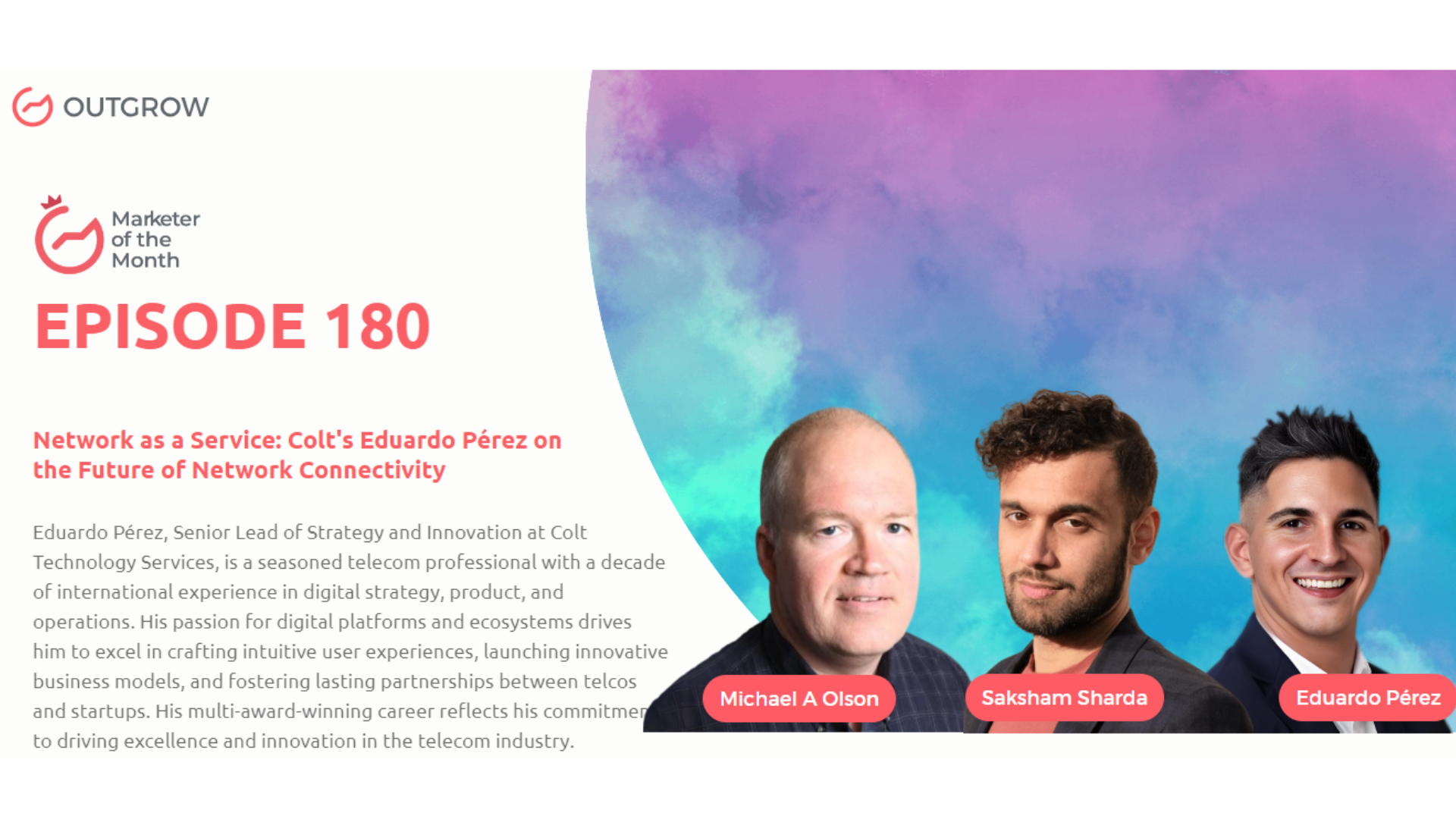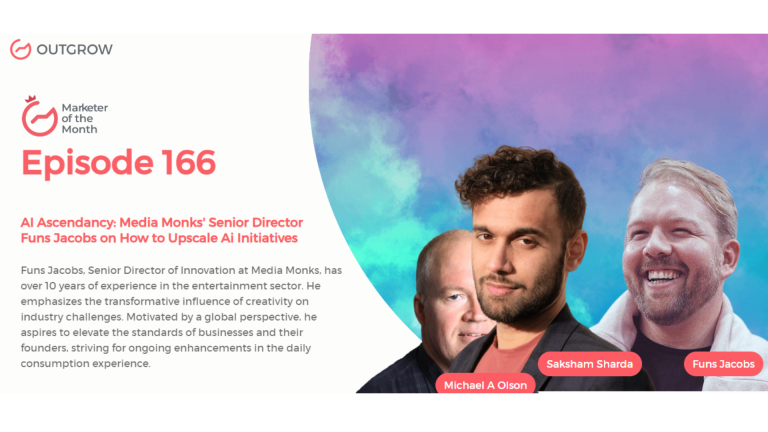Hey there! Welcome to the Marketer Of The Month blog!
We recently interviewed Eduardo Pérez for our monthly podcast – ‘Marketer of the Month’! We had some amazing insightful conversations with Eduardo and here’s what we discussed about-
1. Significance of personal connection and cultural alignment in partnerships.
2. Colt’s identity as a global telecommunication company detailing services and unique digital customer journey.
3. Use of SDN, highlighting the unique approach to digitizing end-to-end processes in real-time.
4. Global digital infrastructure simplifies access to a digital world for enterprises.
5. NAAS (Network as a Service) is a transformative way of delivering connectivity, emphasizing flexibility and real-time consumption.
6. Need for customer engagement, education, and changing industry expectations.
7. Colt’s cultural approach and the revolution towards focusing on product-driven strategies.
About our host:
Dr. Saksham Sharda is the Chief Information Officer at Outgrow.co. He specializes in data collection, analysis, filtering, and transfer by means of widgets and applets. Interactive, cultural, and trending widgets designed by him have been featured on TrendHunter, Alibaba, ProductHunt, New York Marketing Association, FactoryBerlin, Digimarcon Silicon Valley, and at The European Affiliate Summit.
About our guest:
Eduardo Pérez, Senior Lead of Strategy and Innovation at Colt Technology Services, is a seasoned telecom professional with a decade of international experience in digital strategy, product, and operations. His passion for digital platforms and ecosystems drives him to excel in crafting intuitive user experiences, launching innovative business models, and fostering lasting partnerships between telcos and startups. His multi-award-winning career reflects his commitment to driving excellence and innovation in the telecom industry.
EPISODE 180: Network as a Service: Colt’s Eduardo Pérez on the Future of Network Connectivity
Table of Contents
The Intro!
Saksham Sharda: Hi, everyone. Welcome to another episode of Outgrow’s Marketer of the Month. I’m your host, Dr. Saksham Sharda, and I’m the creative director at Outgrow. co. And for this month we are going to interview Eduardo Pérez, who is the Senior Lead of Strategy and Innovation at Colt Technology Services.
Eduardo Pérez: Great to be here. Thank you.
Don’t have time to read? No problem, just watch the Podcast!
Or you can just listen to it on Spotify!
The Rapid Fire Round!

Saksham Sharda: At what age do you want to retire?
Eduardo Pérez: 5 years.
Saksham Sharda: How long does it take you to get ready in the mornings?
Eduardo Pérez: One hour.
Saksham Sharda: How many hours of sleep can you survive on?
Eduardo Pérez: I sleep a lot and I like sleeping. So, a minimum of seven.
Saksham Sharda: Favorite color?
Eduardo Pérez: Blue
Saksham Sharda: What time of day are you most inspired?
Eduardo Pérez: Such a day.
Saksham Sharda: Fill in the blank and upcoming technology trend is ________.
Eduardo Pérez: Network as a service.
Saksham Sharda: The city in which the best kiss of your life happened
Eduardo Pérez: Paris.
Saksham Sharda: Pick one Mark Zuckerberg or Elon Musk?
Eduardo Pérez: None.
Saksham Sharda: The biggest mistake of your career?
Eduardo Pérez: I once thought that someone telling me that something was not possible was true. And eventually, I realized he was wrong.
Saksham Sharda: How do you relax?
Eduardo Pérez: I meditate a lot.
Saksham Sharda: How many cups of coffee do you drink per day?
Eduardo Pérez: I don’t drink coffee.
Saksham Sharda: A habit of yours that you hate.
Eduardo Pérez: I used to bite my nails for the last 30 years basically since I was a kid and for the last couple of months, I think I managed to get it in control.
Saksham Sharda: The most valuable skills you’ve learned in life.
Eduardo Pérez: To be transparent.
Saksham Sharda: Your favorite Netflix show
Eduardo Pérez: The Crown.
Saksham Sharda: One-word description of your leadership style.
Eduardo Pérez: Pathetic I guess.
Saksham Sharda: Top priority in your daily schedule.
Eduardo Pérez: Follow my morning routine.
Saksham Sharda: Ideal vacation spot for relaxation
Eduardo Pérez: Florida, Montana.
Saksham Sharda: Key factor for maintaining a work-life balance.
Eduardo Pérez: Say no a lot.
Saksham Sharda: Memorable career milestone?
Eduardo Pérez: I once became a lead engineer without having an engineering degree.
Saksham Sharda: A recent business innovation that caught your attention?
Eduardo Pérez: I am very intrigued by real telecom marketplaces.
Saksham Sharda: The last film that you saw that had a good impression on you?
Eduardo Pérez: Not much into cinema.
The Big Questions!

Saksham Sharda: That’s the end of the rapid-fire round. Now we can move on to the bigger questions which you can answer with as much ease and time as you’d like.
Michael Olsen: Right now we have today with us Mr. Eduardo Pérez, from Colt and we’re interviewing him here within the context of the total telecom convention. The natural question, of course, is well, what is Colt doing here? What’s their connection to the telecom conference?
Eduardo Pérez: Well. Okay, so basically, we like attending events, but not from just a fun and partying point of view. But the reality is, we believe that this environment makes it much easier to find the right partners for further collaboration in the future, whether it’s about innovation or sales or point or anything like that. Personally, my thing is, by the time I’m able to connect with someone, I understand if there is a real chance that we work together, not because there is a business problem to solve, but because there is some sort of chemistry or alignment from a cultural point of view that would grant us to whatever it is decided in that meeting would have a real future.
Michael Olsen: Okay. Because I’m also interested in a deeper sense, because researching your firm cold, it’s hard to grasp exactly what you do. It seems like maybe you’re like an ISP, but I don’t know on a worldwide scale, please let me invite you, we need to establish it.
Eduardo Pérez: Okay. Colt is a telecommunication company. We are based in London. Our headquarters are in London, but we have a global presence. We’re the biggest fiber provider for bitwise in Europe at the moment after the lumen acquisition. We have a category of tier 1 AS. And mainly, what we do is we enable connectivity for our customers whenever and whatever. However and whenever they need it. Our most important product in the portfolio is, well, we’re one of the few telecommunication providers and one of the first that managed to digitize the entire customer journey. So with us, we can quote, order, activate, modify, and manage your network in real-time. It’s like a cloud-like experience. But in telecommunications, which is unique, because as you may know, those processes take years to complete, in our cases, real-time and digital.
Michael Olsen: And I found the phrase to be Colt IQ network. Is that your brand for your services or just a part of them?
Eduardo Pérez: Yes, in fact, the IQ network will allow us to use the network well with a software component on top. So we’re able to separate what is done physically or by human beings, as compared to what can be done automatically by orchestrators.
Michael Olsen: This crossed my mind. Is this the SDN software-defined network?
Eduardo Pérez: Yes. Yeah, there is a lot of discussion in the industry about what SDN is and what is not. There are a lot of use cases around data centers and so on. In our case, as I told you, we managed to dice the end-to-end process. So for us, the end is the key enabler that allows us to use our network flexibly and deliver to our customers in real time, which is the industry.
Michael Olsen: So global digital infrastructure one could say?
Eduardo Pérez: Yes, the whole thing about global digital infrastructure is that it may have multiple meanings. For us, global global digital infrastructure is basically what allows customers to simplify their access to a digital world. And this could be connected from a connectivity point of view from a security point of view from whatever. So one of the purposes that we have with our initiatives and and our scope of connectivity is understanding what enterprises from different verticals want from telecommunication providers, and being able to deliver that easily in a flexible manner, in a way that addresses their needs in a much easier and faster way, or whatever they’re used to.
Michael Olsen: What they need from telecom providers. So you’re some sort of middleman or middle technology in between then?
Eduardo Pérez: No no we are a telecommunication company. Okay. So, we are the destination for the enterprise.
Michael Olsen: Okay so there’s no question you belong at a telecom conference?
Eduardo Pérez: Yes.
Michael Olsen: Quite a party where you provide voice service, but so much more obviously. than that.
Eduardo Pérez: Yeah. I mean, voice is one of the components, but we have a significant presence in well, the biggest fiber networking in Europe for B2B.
Michael Olsen: I have a couple of network terms here. So picked up the NFV, network function virtualization, and then what might be a bigger concept, the NAAS network as a service. Are those folded into the same concept? Are they separate themes? Or can you discuss it? So both of them belong together?
Eduardo Pérez: Yeah, basically, NAS or network as a service is the framework that allows us to deliver connectivity services to customers in a flexible way and ideally, digitally. However, this kind of connectivity could be Ethernet Access, IP access, access to the cloud, or whatever, er. However, the NFV component, basically what allows it, helps us virtualize specific network functions. So for example, imagine that, instead of having a physical router, in your office, you have the same capability, but it’s already at our edge. So you don’t have to worry about that, you just plug and play. And that port already has the service that you’re looking for, for example, we could have a virtual CPE that contains a firewall or a router, meze one module, and all of that in a single box. But it’s just a piece of software. is like when you go to an Apple store, and you download a specific application, well it’s that equivalent, but in telecommunications, that has a massive benefit from our end point of view. And that’s one of the reasons why we’re doing it because it’s not does not only simplifies the end-to-end experience, but it’s a way of delivering value to a customer in a way that doesn’t affect just the planet but also the operational background.
Michael Olsen: So this network as a service, NAS, it seems quite a breakthrough, really, an innovation or an innovation in the industry, which probably spearheaded your sales, isn’t that it?
Eduardo Pérez: Okay, so, we understand NAS as more than a specific technology or set of technologies as a new way of doing business in telco. There is a technical component, which is SDN, NFV, and so on, while software-defined network and network function virtualization. But ultimately, what the business value is is that we can deliver connectivity to our customers, in a way of uses a digital channel. But most importantly, they can consume this flexibly in real time whenever they need it. That’s the real difference. And it’s like a cloud-like experience but in soccer. If you take into consideration the background of our industry, for an enterprise to have access to connectivity to another site, or the cloud, or to whatever, it may take you a month. So I’m not only talking about going to the place, putting the fiber and configuring the equipment and all of that, but the entire process, the number of engagements that you have with sales, sending the requirements, someone going to the place and putting the fiber configuring the device, managing the invoices and all of that, what we did is we automated the end to end journey. So for us, NAS is not just one new, trendy technology or movement. In my opinion, it’s actually what’s going to save at least the part of the industry where we are working. Of course, we don’t have to worry about 5G investments and 6G investments because we’re not mobile operators. But we think we need to focus on finding differentiation in the industry, we need to find what we need, we’re also worried about commoditization, and we are looking for new ways to find profitability. And that’s really where NAS is an enabler. Because obviously, it adds additional value to our customers. So it makes us more competitive, but at the same time, it significantly reduces the operational pressure to run the whole delivery framework in a telco provider.
Michael Olsen: But did you say it considerably lowers your costs and your efforts in providing services to customers?
Eduardo Pérez: Yes, it does, considering that some of those steps are automated. So it’s not only faster from a customer point of view, but they are currently done by a machine. The important thing here is that the touch points where we want to enhance the experience with our customers, remain. We’re still in contact with our customers. Yes, we’re still in contact with our customers. And, fundamentally, a relationship is built enough, not necessarily face-to-face, but in a more human approach. Let’s not confuse two things. Organizations across the board should focus on obviously improving their processes, automation, whatever. But in the end, it is not only about delivering a service but delivering experience. And that’s really where we want to play. Because, no, it doesn’t matter whether you call a call center, and it takes you X amount of minutes to get your issue resolved. Because it is competitive. Well, KPIs between carriers, it’s pretty much the same. We’re still winning the race, from an employer’s point of view, and so on. But I don’t think that’s the winning factor for a customer these days. What they want is more connectivity for faster access to their connectivity, and flexibility, because their demands are also changing flexibly, the same way that they are modifying their computing power in real-time, they want to do something similar with our network. They want broader access. And that’s also one of the reasons why this lumen acquisition is a massive movement for Colt because now we have a global presence in Europe, and a level of connection and closeness with our customers that we never thought we knew specifically.
Michael Olsen: What I could imagine to be, you know, customer resistance to this new innovative product, either because they can’t be made to understand it, how great it is, how they really should be enthusiastic about it, or just, they’re set in their ways. Surely, there was some sort of element of resistance that you’ve had to overcome? And how did you do that, or maybe there wasn’t?
Eduardo Pérez: Let me put it this way. Every time that we or anyone else innovates something, there is a period that you need to spend engaging with your customers to understand their needs. And eventually, you’re able to address those needs. Eventually, these initial set of customers are like probably your first partners in crime until your product has some sort of evolution. We went very deep in our relationship with our customers for the initial phase, because we wanted to understand really, what were their concerns. Its complexity around processes, the time that it takes, and all of them. So that was completely clear. Now phase two of that plan, or product development is more around education, communication, and brand awareness and changing something that in my opinion, is something very difficult to modify once expectation is that in the industry. Not every customer believes that this is possible. So we need to show them. And that’s why we have intuitive online experiences, why we have webinars, and why we have our salespeople trained to explain to our customers how it works. This is literally where the magic happens. You’re not necessarily a customer, when you’re buying something, you know, all of the capabilities, and especially when it’s something this new, you need to dedicate a huge amount of time training your customers is not as immediate as marketing. Yeah, especially because the kind of customers that would be using calls on demand or as many other platforms are someone who’ll be in direct contact with a new platform. So now the multiple decision-makers within the enterprise have access to a single platform where they can make the requirements they will be able to see it, control it, manage it, and so on. We are talking about people from procurement, we’re talking about people from finance, people from IT network managers,and the actual developers, the service or this platform is also available via API. So our customers can also connect with us via APIs and request services and upgrades and modifications and all of that in real-time. So it’s a new set of customer personas that we need to address individually with a specific plan with a specific communication and specific message for each of them, it would be impossible for anyone introduced into this market to think that I have this capability. Now my customers are going to know how it works. Because we’re transforming the way the industry is behaving.
Michael Olsen: Okay, very interesting, training your customers. But if I may, most people would more readily think about training their employees. And indeed, you’re the senior lead for strategy and innovation, presumably the head of a critical department along those lines, you know, what, what are your measures to form and to maintain the sort of company culture that you want to see, they’re a culture that fosters innovation, and that is able, indeed, to spread the message that you just talked about, in the right way to customers who need to be trained to appreciate what they can get from you.
Eduardo Pérez: So I’ll probably break that problem into separate pieces. Okay. A, one of them is we first need to focus on creating an organization more product driven, that follows product processes and product mindset across different parts of the business. By this I mean, having closer contact with our customers, really understanding what they need, and what they want, assessing that market-wise, being able to understand what our competitors are doing, and not necessarily replicating what they are doing. But finding and sending the message to the teams is not only about replicating what the competition is doing but finding our own space of competition. This is interesting in the digital space. Because more and more, especially in telecommunications, everybody’s used to delivering the same Ethernet product, and the same IP access, the level of differentiation is very little. However, in digital, we have this massive opportunity to deliver something new, different, and cost-effective. So that is one of the messages people need to understand. It’s not only about replicating, but it’s also about being much closer to the customer. The other point is about sustaining this in time. And I think that the whole component or the key component to making this happen is around people having trust in the decisions that they make and giving them the space to fail without massive consequences for that. Ultimately, this doesn’t happen alone, everybody’s talking about, oh, yeah, we want to create safer spaces for the team. But how? That’s how the whole cultural discussion started. I mean, we all want to have a happy workplace now. But I don’t think that they are like magic bullets for any of this, in our experience, and one of the things that happens in Colt, more and more, and I think it’s driving a massive change. There are two, one of them is direct and open communication from the different levels top down, but also bottom up. And also, this is controversial for some, but it is like accepting our vulnerability, and that we all mess it up a lot. And when we have meetings, we are perfectly fine to say, look, this didn’t go on as expected. And it’s fine, it is not a big deal to come back to our team meeting and say, look, it didn’t go as we expected it to. We didn’t take that requirement, it failed. That part just didn’t work. The thing is, it’s impossible to create an environment where people feel okay to work with you if they don’t know how they can connect with you and how you can connect with them. So I don’t know how to find the right word for this but often it is more about removing all of the typical corporate rules we have learned until now and being able to just build your new rules, but not necessarily globally. Start with your team. Try to create a movement where that happens and works. Let others see. While the benefits of doing it that way. The whole problem with cultural confirmation is that it usually is often perceived as a mandate. And it’s not. It is just the opposite of someone leading by example. And if you’re lucky, like we are to have a CEO with the power of communication and real conviction of what we work with, what is the good thing to do is great, but you may even have a good culture, even if your leadership is not as good as you would like. And I don’t know, my suggestion, as it is just well, to my partners, to my friends, to my team is on. Just do it locally. If it’s good, some others will replicate it. So start with that.
Saksham Sharda: Alright. So the last question for you is of a personal kind. What would you be doing in your life, if not this?
Eduardo Pérez: I would be a surfer.
Let’s Conclude!
Saksham Sharda: Thanks, everyone for joining us for this month’s episode of Outgrow’s Marketer of the Month. That was Eduardo Pérez, who is the Senior Lead of strategy and innovation at Colt Technology Services.
Eduardo Pérez: Great to be here. Thank you.
Saksham Sharda: Check out the website for more details and we’ll see you once again next month with another marketer of the month.



